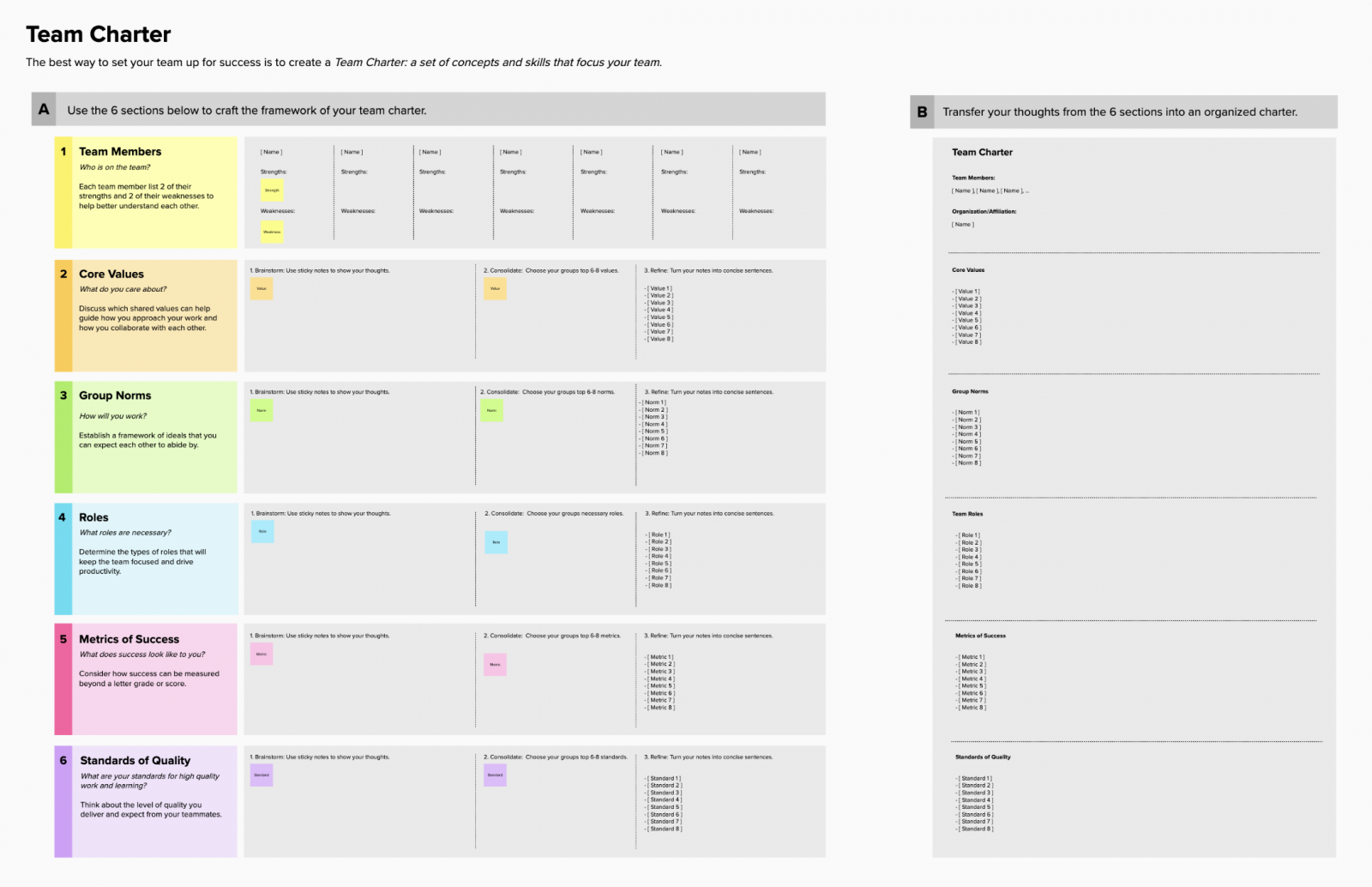
Engaging the whole team through a Team Charter remote session
Published: June 10, 2021
Remote work has been an increasingly present companion for all of us in software development. It was in the spotlight especially in 2020, when the pandemic kept us all locked in our homes. In this remote work "Big Bang", we realized that the challenges of teamwork are intensified due to variables that go beyond the project itself. The team is made of people, and people have different routines, habits, and in most cases, different time zones. In addition, each individual has their own background, with strengths and challenges, passing through different moments of their journey. How to strengthen a team made up of people with such different routines and working remotely? How can we explore what each of these people has best to offer to generate more collaboration?
A Team Charter session can prove a great tool to create a positive mood, to enhance and inspire teamwork, helping people recognize and share their strengths and challenges, their visions of success and personal metrics. It works as a guide on how to restate your team as a group of people who share the same goals, work collaboratively and deliver quality.

So, this is how it works:
1. Members of the team
Who is on your team? Get to know your colleagues better.
Each team member lists 2 of their strengths and 2 of their undeveloped skills, to help them understand each other better.
2. Fundamental values
What do you care about? Find out what motivates you the most.
Discuss which shared values can determine how you approach your work and how you collaborate.
3. Group Norms
How are you going to work? Set rules that help you do your part in the team.
Establish a framework of ideals that you expect each one to fulfill.
4. Roles
What roles are needed?
Determine the types of roles that will keep the team focused and increase productivity.
5. Metrics of success
What is success for you?
Consider how success can be measured beyond a grade or score.
6. Quality Standards
What are your standards for high-quality work and learning?
Think about the level of quality you offer and expect from your teammates.
The facilitator can pose some provocations to stimulate the brainstorm, for example:
Team rules:
What qualities do you look for in new talents for the team?
How does the ideal teamwork look for you?
If failures occur, what comes next?
Metrics of success:
What does success mean to you?
What results or behaviors can generate a meaningful impact?
What results or behaviors require corrective action?
Using the "Begin Voting" button, set the voting time for each section (when conducting my session, I found that 3 minutes are enough). The team must read all cards and vote on a maximum of 4 items. End the voting and, with the team, choose from 4 to 6 most voted cards in each section.
Through this culture deck, we have a better understanding of the way the team prefers to work together, which helps us avoid behaviors and practices that can be obstacles to communication and product quality. In addition, we can see the pain points of the current roles and analyze whether the team needs any other role in the development process.
With a team that shares the same values, the same vision of success, the same quality standards, and supports each member, you can always build a unit, and not just a group of people who work together. They will all gradually gain the ability to see the bigger picture and clearer goals, to deliver faster, better outputs, with less effort and more ease and precision.
A Team Charter session can prove a great tool to create a positive mood, to enhance and inspire teamwork, helping people recognize and share their strengths and challenges, their visions of success and personal metrics. It works as a guide on how to restate your team as a group of people who share the same goals, work collaboratively and deliver quality.
How to run a Team Charter session remotely
This is a collaborative and really fun process. Running it with my team, I used the MURAL tool, which allows people to collaborate simultaneously and remotely through sticky notes, based on a range of templates - it's worth remembering that the tool was added to our Tech Radar in 2020 as a Trial-Tool. The template used is the Team Charter.
So, this is how it works:
Brainstorm for each section
The team must place sticky notes simultaneously for 3 minutes, for each section. The sections are divided into:1. Members of the team
Who is on your team? Get to know your colleagues better.
Each team member lists 2 of their strengths and 2 of their undeveloped skills, to help them understand each other better.
2. Fundamental values
What do you care about? Find out what motivates you the most.
Discuss which shared values can determine how you approach your work and how you collaborate.
3. Group Norms
How are you going to work? Set rules that help you do your part in the team.
Establish a framework of ideals that you expect each one to fulfill.
4. Roles
What roles are needed?
Determine the types of roles that will keep the team focused and increase productivity.
5. Metrics of success
What is success for you?
Consider how success can be measured beyond a grade or score.
6. Quality Standards
What are your standards for high-quality work and learning?
Think about the level of quality you offer and expect from your teammates.
The facilitator can pose some provocations to stimulate the brainstorm, for example:
Team rules:
What qualities do you look for in new talents for the team?
How does the ideal teamwork look for you?
If failures occur, what comes next?
Metrics of success:
What does success mean to you?
What results or behaviors can generate a meaningful impact?
What results or behaviors require corrective action?
Consolidate ideas
Using the "Begin Voting" button, set the voting time for each section (when conducting my session, I found that 3 minutes are enough). The team must read all cards and vote on a maximum of 4 items. End the voting and, with the team, choose from 4 to 6 most voted cards in each section.Turn your notes into concise phrases
It's time to create phrases that represent ideas collectively. Start from the most voted sticky notes and use the plurals "us/ours" constantly. This is essential.Transfer the thoughts in the 6 sections to create your Team Charter
Use the template on the right to formalize the team's culture deck. In my experience, a whole hour is enough to complete the sessions, carry out the voting and consolidate it.Collect the results
As a suggestion, a very interesting step after the session is drawing up a professional development plan for each member. This way, we will be able to better understand where everyone is in their professional journey, and where we can apply their strengths or offer our support to help them work on their particular challenges.Through this culture deck, we have a better understanding of the way the team prefers to work together, which helps us avoid behaviors and practices that can be obstacles to communication and product quality. In addition, we can see the pain points of the current roles and analyze whether the team needs any other role in the development process.
With a team that shares the same values, the same vision of success, the same quality standards, and supports each member, you can always build a unit, and not just a group of people who work together. They will all gradually gain the ability to see the bigger picture and clearer goals, to deliver faster, better outputs, with less effort and more ease and precision.
Disclaimer: The statements and opinions expressed in this article are those of the author(s) and do not necessarily reflect the positions of Thoughtworks.

















